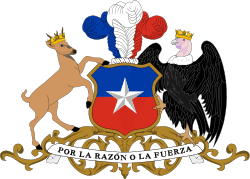Environmental issues in Chile
This page covers environmental issues in Chile.
Overview
The country of Chile is a virtual continental island bounded by the Pacific Ocean on the west, the Andes Mountains on the east, and the Atacama Desert in the north; it is home to several important ecoregions, such as the Chilean Winter Rainfall-Valdivian Forests, a biodiversity hotspot that harbors richly endemic flora and fauna, and the Tropical Andes, which stretches into northern Chile.[1]
There are endangered species in Chile, including the South Andean huemul, tundra peregrine falcon, puna rhea, Chilean woodstar, ruddy-headed goose, and green sea turtle. As of 2001, 16 species of mammals in a total of 91 were considered endangered. Of 296 breeding bird species, 18 were threatened with extinction. Also threatened were four types of freshwater fish and 268 plant species.[2]
Prominent issues
There are a series of environmental issues in this country, with a dynamic and diversified economy. Chile's main environmental problems are deforestation and the resulting soil erosion.[2] From 1985 to 1995, Chile lost nearly 2 million hectares of native forest; these forests were destroyed for pulp, and made way for industrial tree farms. As a result, Chile now has the world's largest expanse of radiata pine tree farms and some of the world's most endangered native forests.[3]
Air pollution from industry and transportation and water pollution are especially acute in urban centers. In 1996, Chile's industrial carbon dioxide emissions totaled 48.7 million metric tons. Untreated sewage poses the major threat to the nation's water quality. As of 2001, Chile had 928 cu km of renewable water resources. While 99% of its urban dwellers have pure drinking water, only 58% of its rural dwellers have the same access.[2] Chile is one of the major mining countries of the world and big-scale mining also represents an important environmental challenge. Severe water shortages affecting many local communities were due not only to persistent drought but to structural problems in the policies governing the exploitation of natural resources, including privatized water management; this led to big protests.[4]
Water Pollution
Much of Chile’s water resources are privatized due to the 1981 Water Code which created a market based on water rights.[5] Water is treated as an asset where once an individual or private company receives water rights, they can choose to sell or rent water. The concentration of water resources in the hands of a few corporations has resulted in Chile having the highest water rates in Latin America. Nearly 90% of the water rights for hydroelectric production are owned by three companies.[5] There are more water rights that have been issued than there are reserves in some parts of the country which has led to the drying up of groundwater resources. This shortage has particularly affected the rural and indigenous population of Chile.
The mining industry has had a considerable impact on the environment of Chile. One region in particular that been significantly impacted is that of the Atacama Desert, which is considered one of the driest regions in the world.[6] Mining requires a large quantity of water, with much of this water coming from groundwater supplies. Dust from mining operations can also accelerate the melting of snow deposits on the Andean glaciers.[6] This puts a considerable strain on snowmelt water supplies which harms the rural communities living in the Atacama. Another source of pollution results from the mining of lithium within some of the lakes in the region. This has the potential to affect local flamingo population as they are reliant on the lakes as a source of shrimp.[6]
Air Pollution
Increased economic activity has resulted in a degradation of Chile’s air quality. Santiago, the capital city of Chile, is surrounded by mountain ranges which facilitates the accumulation of pollutants from car emissions and industrial development over the region.[7] Hospitals become overcrowded as a result of respiratory related problems each year in Santiago. The air pollution in Santiago has resulted in an average of 20,000 people suffering from respiratory problems every year.[7] It is common to use wood for heating in the southern portion of Chile, which tends to experience cold temperatures, as it is less costly than gas or electricity.[8]
See also
References
- ↑ Chile - Encyclopedia of Earth
- 1 2 3 "Chile-Environment". NationsEncyclopedia.com. Retrieved 19 January 2014.
- ↑ "Plantations in Chile trampling native forests". WWF. Retrieved 19 January 2014.
- ↑ "Mining and logging companies 'leaving all of Chile without water'". The Guardian. 24 April 2013.
- 1 2 Larrain, Sara. "Conflicts over Water in Chile: Between Human Rights and Market Rules" (PDF). chilesustentable.net.
- 1 2 3 Zubkova, Marketa (10 October 2008). "Current Issues in the Chilean Mining Sector" (PDF). SDSG.
- 1 2 Garcia-Chevesich, Pablo A. (31 December 2013). "Respiratory disease and particulate air pollution in Santiago Chile: Contribution of erosion particles from fine sediments" (PDF). Environmental Pollution. 187: 202–205. doi:10.1016/j.envpol.2013.12.028.
- ↑ Pino, Paulina (May–June 2015). "Chile Confronts its Environmental Health Future After 25 Years of Accelerated Growth". Annals of Global Health. 81: 354–367. doi:10.1016/j.aogh.2015.06.008.
External links
- "Key Environmental Issues in Chile". GRRT. Retrieved 19 January 2014.

